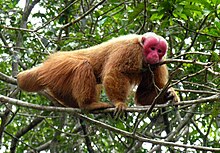Uakari
| Uakari[1] | |
|---|---|

| |
| Bald uakari (Cacajao calvus) | |
| Scientific classification | |
| Kingdom: | Animalia |
| Phylum: | Chordata |
| Class: | Mammalia |
| Order: | Primates |
| Suborder: | Haplorhini |
| Infraorder: | Simiiformes |
| Family: | Pitheciidae |
| Subfamily: | Pitheciinae |
| Genus: | Cacajao Lesson, 1840 |
| Type species | |
| Simia melanocephalus Humboldt, 1812
| |
| Species | |
|
Cacajao melanocephalus | |
Uakari (UK: /wəˈkɑːri/,[2] US: /wɑː-/)[3] is the common name for the New World monkeys of the genus Cacajao. Both the English and scientific names are believed to have originated from indigenous languages.[4]
The uakaris are unusual among New World monkeys in that the tail length (15–18 cm) is substantially less than their head and body length (40–45 cm). Their bodies are covered with long, loose hair but their heads are bald. They have almost no subcutaneous fat, so their bald faces appear almost skull-like. Like their closest relatives the saki monkeys, they have projecting lower incisors. These monkeys have the most striking red facial skin of any primate. Females choose their mates based on how red the male's face is. Evidence suggests that the red facial coloration reflects the health of the primate.[5]
The four species of uakari currently recognized are all found in the north-western Amazon basin. The bald uakari, remarkable for its brilliant scarlet complexion,[6] is found north of the Amazon River, and south of the Japurá River in the Mamirauá Sustainable Development Reserve. The black-headed uakari is found north of the Amazon and south of the Rio Negro. The Neblina uakari is found north of the Rio Negro, west of the Rio Marauiá and east of the Casiquiare canal. The Aracá uakari is currently known only from the Rio Curuduri basin.
Uakaris are typically lethargic and silent in zoo conditions, but in the wild they are agile and active, capable of leaps of over 6 meters.[citation needed] They have been observed both in small groups and in larger troops of up to 100. When traveling through the forest they move in the lower branches of the trees, though when foraging they also go up to the canopy. They eat fruit, nuts, buds and leaves.[citation needed]
Uakari are found in neotropical Amazon flooded or riparian forests, including Brazil, Colombia, Peru and Venezuela.[7]
Species[]
There are four species in this genus:[1][8]
- Genus Cacajao
- Bald uakari or red uakari, C. calvus
- Cacajao calvus calvus
- Cacajao calvus ucayalii
- Cacajao calvus rubicundus
- Cacajao calvus novaesi
- Bald uakari or red uakari, C. calvus
- Black-headed uakari species group
- Golden-backed uakari, Cacajao melanocephalus
- Aracá uakari, Cacajao ayresi*
- Neblina uakari, Cacajao hosomi*
In 2014 Ferrari et al. proposed an alternative taxonomy which recognizes the Aracá uakari as a subspecies of the golden-backed uakari, and also recognized Cacajao ouakary as a separate species.[9][10] This revision is not universally accepted.[11]

References[]
- ^ Jump up to: a b Groves, C. P. (2005). "Genus Cacajao". In Wilson, D. E.; Reeder, D. M (eds.). Mammal Species of the World: A Taxonomic and Geographic Reference (3rd ed.). Johns Hopkins University Press. p. 146. ISBN 978-0-8018-8221-0. OCLC 62265494.
- ^ "Uakari". Lexico UK Dictionary. Oxford University Press.
- ^ "Uakari". Merriam-Webster Dictionary.
- ^ Barnett, Adrian A. (December 2004). "The Meanings of Cacajao and Uacari: Folk Etymology in Neotropical Primate Taxonomy". Neotropical Primates. 12 (3): 147–152. doi:10.1896/1413-4705.12.3.147. ISSN 1413-4705.
- ^ Corso, Josmael; Bowler, Mark; Heymann, Eckhard W.; Roos, Christian; Mundy, Nicholas I. (2016-04-13). "Highly polymorphic colour vision in a New World monkey with red facial skin, the bald uakari ( Cacajao calvus )". Proceedings of the Royal Society B: Biological Sciences. 283 (1828): 20160067. doi:10.1098/rspb.2016.0067. ISSN 0962-8452. PMC 4843651. PMID 27053753.
- ^ Wolfe, A. (1997) Primates, San Francisco: Chronicle Books, p. 159
- ^ Gron, K.J. (July 21, 2008). "Primate Factsheets: Uakari (Cacajao) Taxonomy, Morphology, & Ecology". Retrieved July 1, 2012.
- ^ Boubli, J. P.; M. N. F. da Silva; M. V. Amado; T. Hrbek; F. B. Pontual; I. P. Farias (2008). "A taxonomic reassessment of black uakari monkeys, Cacajao melanocephalus group, Humboldt (1811), with the description of two new species" (PDF). International Journal of Primatology. 29: 723–749. doi:10.1007/s10764-008-9248-7. Archived from the original (PDF) on 2008-10-31.
- ^ Ferrari, Stephen F.; Guedes, Patricia G.; Figueriredo-Ready, Wilsea M.B.; Barnett, Adrian A. (2014). "Reconsidering the taxonomy of the Black-Faced Uacaris, Cacajao melanocephalus group (Mammalia: Pitheciidae), from the northern Amazon Basin". Zootaxa. 3866 (3): 353–370. doi:10.11646/zootaxa.3866.3.3. PMID 25283664.
- ^ "Cacajao". ASM Mammal Diversity Database. Retrieved 2019-07-24.
- ^ "Cacajao". ITIS. Retrieved 2019-07-24.
External links[]
| Wikispecies has information related to Uakari. |
| Wikimedia Commons has media related to Cacajao. |
- Sakis and uakaris



